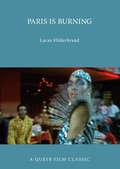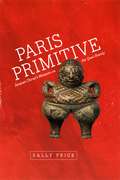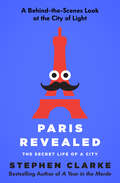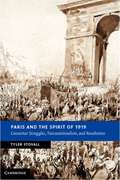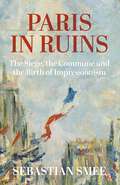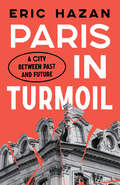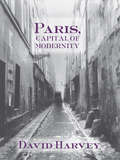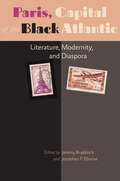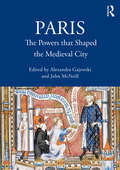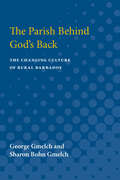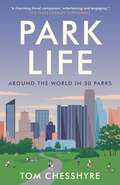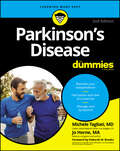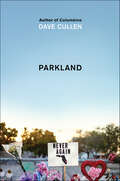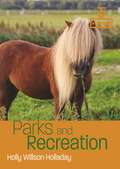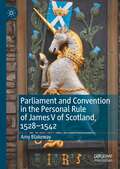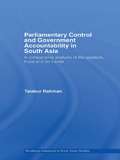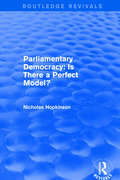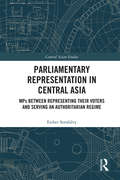- Table View
- List View
Paris Is Burning
by Lucas HilderbrandParis Is Burning (Jennie Livingston, 1991) captures the energy, ambition, wit, and struggle of African-American and Latino participants in the 1980s New York drag ball scene. This book contextualizes the film within the longer history of drag balls, the practices of documentary, the fervor of the culture wars, and the development of queer theory and critical race studies.
Paris Primitive: Jacques Chirac's Museum on the Quai Branly
by Sally PriceParis Primitive recounts the massive reconfiguration of Paris’s museum world that resulted from Chirac’s dream, set against a backdrop of personal and national politics, intellectual life, and the role of culture in French society. Along with exposing the machinations that led to the MQB’s creation, Sally Price addresses the thorny questions it raises about the legacy of colonialism, the balance between aesthetic judgments and ethnographic context, and the role of institutions of art and culture in an increasingly diverse France.
Paris Revealed: The Secret Life of a City
by Stephen ClarkeA hilarious insider&’s guide to Paris by the author of 1000 Years of Annoying the French: &“Clarke&’s eye for detail is terrific&” (The Washington Post). Stephen Clarke may have adopted Paris as his home, but he still has an Englishman&’s eye for the people, cafés, art, sidewalks, food, fashion, and romance that make Paris a one-of-a-kind city. This irreverent outsider-turned-insider guide shares local savoir faire, from how to separate the good restaurants from the bad to navigating the baffling Métro system. It also provides invaluable insights into the etiquette of public urination and the best ways to experience Parisian life without annoying the Parisians (a truly delicate art). Clarke&’s witty and expert tour of the city leaves no boulevard unexplored—even those that might be better left alone.
Paris and the Spirit of 1919
by Tyler StovallThis transnational history of Paris in 1919 explores the global implications of the revolutionary crisis of French society at the end of World War I. As the site of the peace conference Paris was a victorious capital and a city at the center of the world, and Tyler Stovall explores these intersections of globalization and local revolution. The book takes as its central point the eruption of political activism in 1919, using the events of that year to illustrate broader tensions in working class, race, and gender politics in Parisian, French, and ultimately global society which fueled debates about colonial subjects and the empire. Viewing consumerism and consumer politics as key both to the revolutionary crisis and to new ideas about working class identity, and arguing against the idea that consumerism depoliticized working people, this history of local labor movements is a study in the making of the modern world.
Paris at War: 1939-1944
by David DrakeDavid Drake chronicles the lives of ordinary Parisians during WWII, drawing on diaries and reminiscences of people who endured these years. From his account emerge the broad rhythms and shifting moods of the city and the contingent lives of resisters, collaborators, occupiers, and victims who, unlike us, could not know how the story would end.
Paris in Ruins: The Siege, the Commune and the Birth of Impressionism
by Sebastian SmeePulitzer-winner Sebastian Smee relives the remarkable birth of Impressionism from the ashes of war Paris, January 1871 – the final, agonising days of the Franco-Prussian War. As the German army cements its advantage, shells rattle through the Left Bank. It is a bitterly cold winter; there is no fuel, no medicine, no food. The city&’s poorer citizens have long turned to eating rats, cats and dogs. France has been brought to its knees. Édouard Manet, Berthe Morisot, and Edgar Degas are trapped in the besieged city. Renoir and Bazille have joined regiments outside of Paris, while Monet and Pissarro fled the country just in time. Out of the Siege and the Commune, these artists developed a newfound sense of the fragility of life. A feeling for transience – reflected in Impressionism&’s emphasis on fugitive light, shifting seasons, glimpsed street scenes, and the impermanence of all things – would change art history forever. This is the extraordinary account of the &‘Terrible Year&’ in Paris and its monumental impact on the rise of Impressionism.
Paris in Turmoil: A City between Past and Future
by Eric HazanA kaleidoscopic look at Paris&’s ever-changing forms and people"Since the disastrous Pompidou years, working-class Paris has been steadily nibbled away, either by destruction or more insidiously by a kind of internal colonization. Take for example a small outlying district populated by Arabs, blacks and poor whites twenty years ago, the L&’Olive neighbourhood north of La Chapelle The area is noted as pleasant, people frequent it and explore it, and as the rents are low some settle there. Others follow, first friends and then anyone else. Rents go up, buildings are renovated, bars open, then an organic food shop, a vegan restaurant... The earlier indigenous inhabitants are driven out by the rising rents and settle further away, in Saint-Denis if they are lucky, or else in Garges-lès-Gonesse, Goussainville or God knows where. "But new neighbourhoods are emerging, for example the Chinese quarter of Bas Belleville, which has grown since the 1970s to the point that in some streets, such as Rue Civiale or Rue Rampal, the restaurants and shops are all Chinese, with many Chinese sex workers on Boulevard de la Villette. These Chinese almost all come from Wenzhou, a large province south of Shanghai, whose inhabitants are reputedly known for their commercial skills."Paris is constantly changing as a living organism, both for better and for worse. This book is an incitement to open our eyes and lend an ear to the tumult of this incomparable capital, from the Périphérique to Place Vendôme, its markets of Aligre and Belleville, its cafés and tabacs, its history from Balzac to Sartre. In some thirty succinct vignettes, from bookshops to beggars, Art Nouveau to street sounds, Parisian writers to urban warts, Jacobins to Surrealism, Hazan offers a host of invaluable aperçus, illuminated by a matchless knowledge of his native city.
Paris, Capital of Modernity
by David HarveyCollecting David Harvey's finest work on Paris during the second empire, Paris, Capital of Modernity offers brilliant insights ranging from the birth of consumerist spectacle on the Parisian boulevards, the creative visions of Balzac, Baudelaire and Zola, and the reactionary cultural politics of the bombastic Sacre Couer. The book is heavily illustrated and includes a number drawings, portraits and cartoons by Daumier, one of the greatest political caricaturists of the nineteenth century.
Paris, Capital of the Black Atlantic: Literature, Modernity, and Diaspora (A <I>Modern Fiction Studies</I> Book)
by Jonathan P. Eburne Jeremy BraddockHow black writers’ travel to Paris contributed to the transatlantic circulation of art and ideas.Paris has always fascinated and welcomed writers. Throughout the twentieth and into the twenty-first century, writers of American, Caribbean, and African descent were no exception. Paris, Capital of the Black Atlantic considers the travels made to Paris—whether literally or imaginatively—by black writers. These collected essays explore the transatlantic circulation of ideas, texts, and objects to which such travels to Paris contributed. Editors Jeremy Braddock and Jonathan P. Eburne expand upon an acclaimed special issue of the journal Modern Fiction Studies with four new essays and a revised introduction. Beginning with W. E. B. Du Bois’s trip to Paris in 1900 and ending with the contemporary state of diasporic letters in the French capital, this collection embraces theoretical close readings, materialist intellectual studies of networks, comparative essays, and writings at the intersection of literary and visual studies. Paris, Capital of the Black Atlantic is unique both in its focus on literary fiction as a formal and sociological category and in the range of examples it brings to bear on the question of Paris as an imaginary capital of diasporic consciousness.
Paris, Capital of the Black Atlantic: Literature, Modernity, and Diaspora (A Modern Fiction Studies Book)
by Jonathan P. Eburne Jeremy Braddock“How African-American artists and intellectuals sought greater liberty in Paris while also questioning the extent of the freedoms they so publicly praised.” —American Literary HistoryParis has always fascinated and welcomed writers. Throughout the twentieth and into the twenty-first century, writers of American, Caribbean, and African descent were no exception. Paris, Capital of the Black Atlantic considers the travels made to Paris—whether literally or imaginatively—by black writers. These collected essays explore the transatlantic circulation of ideas, texts, and objects to which such travels to Paris contributed.Editors Jeremy Braddock and Jonathan P. Eburne expand upon an acclaimed special issue of the journal Modern Fiction Studies with four new essays and a revised introduction. Beginning with W. E. B. Du Bois’s trip to Paris in 1900and ending with the contemporary state of diasporic letters in the French capital, this collection embraces theoretical close readings, materialist intellectual studies of networks, comparative essays, and writings at the intersection of literary and visual studies. Paris, Capital of the Black Atlantic is unique both in its focus on literary fiction as a formal and sociological category and in the range of examples it brings to bear on the question of Paris as an imaginary capital of diasporic consciousness.“Demonstrate[s] how Black writers shaped history and contributed to conflicting notions of modernity hosted in Paris . . . The wide range of writers and scholars from American and Francophone studies makes this collection very original and an exciting adventure in concepts, movements, and ideologies that could be acceptable to non-specialists as well.” —American Studies
Paris: The Powers that Shaped the Medieval City (The British Archaeological Association Conference Transactions)
by John McNeill Alexandra GajewskiParis: The Powers That Shaped the Medieval City considers the various forces – royal, monastic and secular – that shaped the art, architecture and topography of Paris between c. 1100 and c. 1500, a period in which Paris became one of the foremost metropolises in the West. The individual contributions, written by an international group of scholars, cover the subject from many different angles. They encompass wide-ranging case studies that address architecture, manuscript illumination and stained glass, as well as questions of liturgy, religion and social life. Topics include the early medieval churches that preceded the current cathedral church of Notre-Dame and cultural production in the Paris area in the late 12th and early 13th centuries, as well as Paris’s chapels and bridges. There is new evidence for the source of the c. 1240 design for a celebrated window in the Sainte-Chapelle, an evaluation of the liturgical arrangements in the new shrine-choir of Saint-Denis, built 1140–44, and a valuable assessment of the properties held by the Cistercian Order in Paris in the Middle Ages. Also, the book investigates the relationships between manuscript illuminators in the 14th century and representations of Paris in manuscripts and other media up to the late 15th century. Paris: The Powers That Shaped the Medieval City updates and enlarges our knowledge of this key city in the Middle Ages and is for medieval archaeologists and historians.
Parisar Adyayan Bhag-1 class 4 - Maharashtra Board: परिसर अध्ययन भाग-१ ४थीं कक्षा - महाराष्ट्र बोर्ड
by Maharashtra Rajya Pathyapustak Nirmiti Va Abhysakram Sanshodhan Mandal Pune"परिसर अध्ययन (भाग 1)" महाराष्ट्र राज्य पाठ्यपुस्तक मंडल द्वारा प्रकाशित चौथी कक्षा के लिए एक महत्वपूर्ण पाठ्यपुस्तक है। यह पुस्तक विद्यार्थियों को उनके प्राकृतिक, सामाजिक, और सांस्कृतिक परिवेश को समझने में मदद करती है। इसमें प्राणियों, पौधों, जल, हवा, मानचित्र, परिवहन, संचार, प्राकृतिक आपदाएँ और सामूहिक जीवन जैसे विषयों को सरल और रोचक भाषा में प्रस्तुत किया गया है। पुस्तक का उद्देश्य बच्चों में पर्यावरणीय जागरूकता बढ़ाना, सामूहिक उत्तरदायित्व सिखाना और जीवन कौशल विकसित करना है। इसके अध्याय गतिविधियों, स्वाध्याय और रोचक चित्रों से भरे हैं, जो बच्चों की कल्पनाशक्ति और रचनात्मकता को प्रेरित करते हैं। यह पुस्तक बच्चों को पर्यावरण का सम्मान करना, संसाधनों का उपयोग सही तरीके से करना, और वैज्ञानिक दृष्टिकोण अपनाने के लिए प्रेरित करती है। यह बच्चों के व्यवहार, ज्ञान और सोचने की क्षमता को सुधारने में मददगार है।
Parisar Adyayan Bhag-1 class 5 - Maharashtra Board: परिसर अध्ययन भाग-१ ५वीं कक्षा - महाराष्ट्र बोर्ड
by Maharashtra Rajya Pathyapustak Nirmiti Va Abhysakram Sanshodhan Mandal Pune"परिसर अध्ययन भाग 1" महाराष्ट्र बोर्ड की कक्षा 5 की हिंदी पाठ्यपुस्तक है, जो प्राकृतिक, सामाजिक और सांस्कृतिक परिवेश की जानकारी प्रदान करती है। इसमें छात्रों को पृथ्वी, पर्यावरण, मानचित्र, नागरिक शास्त्र, परिवार, सार्वजनिक सुविधाएँ, जल स्रोत, खाद्य सुरक्षा, संचार, परिवहन, स्वास्थ्य और समुदाय से जुड़ी मूलभूत अवधारणाएँ सिखाई जाती हैं। पुस्तक में वैज्ञानिक दृष्टिकोण विकसित करने पर बल दिया गया है और छात्र गतिविधियों के माध्यम से व्यावहारिक ज्ञान प्राप्त कर सकते हैं। इसमें चित्र, मानचित्र, प्रश्नोत्तर, और व्यावहारिक गतिविधियाँ शामिल हैं, जो छात्रों को अपने आसपास के वातावरण को समझने और उसमें सुधार करने के लिए प्रेरित करती हैं। इस पाठ्यपुस्तक का उद्देश्य बच्चों को आत्मनिर्भर और जागरूक नागरिक बनाना है, जो समाज और पर्यावरण के प्रति उत्तरदायी हों।
Parisar Adyayan class 3 - Maharashtra Board: परिसर अध्ययन ३रीं कक्षा - महाराष्ट्र बोर्ड
by Maharashtra Rajya Pathyapustak Nirmiti Va Abhysakram Sanshodhan Mandal Pune"परिसर अध्ययन - तीसरी कक्षा (हिंदी माध्यम)" पुस्तक छात्रों को उनके आसपास के प्राकृतिक, सामाजिक और सांस्कृतिक परिवेश की जानकारी देने के लिए बनाई गई है। यह पाठ्यपुस्तक महाराष्ट्र राज्य पाठ्यपुस्तक निर्मिति एवं अभ्यासक्रम संशोधन मंडल द्वारा प्रकाशित की गई है और इसमें प्राथमिक शिक्षा के अनुरूप सरल भाषा में विषयों को प्रस्तुत किया गया है। पुस्तक में भारत के संविधान, मूल कर्तव्य, पर्यावरण अध्ययन, जलवायु परिवर्तन, प्राकृतिक संसाधन, वन्य जीवन, मानव समुदाय, परिवहन एवं संचार, स्वास्थ्य एवं स्वच्छता जैसे महत्वपूर्ण विषयों को शामिल किया गया है। इसमें छात्रों को व्यावहारिक ज्ञान देने के लिए चित्र, गतिविधियाँ, पर्यवेक्षण, प्रश्नोत्तर और स्व-अध्ययन सामग्री दी गई है। इसके माध्यम से बच्चों को पर्यावरण की रक्षा, सामाजिक समरसता, विज्ञान एवं प्रौद्योगिकी की समझ, और नागरिक जिम्मेदारियों के बारे में जागरूक किया जाता है। शिक्षकों और अभिभावकों के मार्गदर्शन से यह पुस्तक बच्चों में ज्ञान अर्जन, अन्वेषण और विश्लेषणात्मक सोच को विकसित करने में सहायक सिद्ध होती है। यह पुस्तक न केवल पाठ्यक्रम का हिस्सा है, बल्कि बच्चों को जिम्मेदार नागरिक बनने की दिशा में भी प्रेरित करती है।
Parish behind God's Back: The Changing Culture of Rural Barbados
by George Gmelch Sharon Bohm GmelchOne of the first things any visitor to Barbados notices is Barbadian youths wearing baseball caps and T-shirts sporting the logos of North American teams; and these days, one is more likely to find an American sitcom on television than a Caribbean program. The Parish behind God's Back describes the social fabric and everyday life of one rural parish on the island, St. Lucy, including its many links to the outside world. It is a contemporary ethnography of the local that takes into account the enormous influence of global factors such as tourism, television, foreign travel, and return migrants. Written with students in mind, the book contains several unique features. Each chapter blends descriptions of Barbadian culture with comparisons to North America; throughout, the authors include tales of not only their own fieldwork experiences but those of their undergraduate students; and personal narratives are emphasized to engage interest in individuals. This highly readable and thought-provoking account should appeal to general readers with an interest in the Caribbean as well as to students of anthropology. George Gmelch is Professor and Chair, Department of Anthropology, Union College. Sharon Bohn Gmelch is Professor of Anthropology and Director of Women's Studies, Union College.
Park Cruising: What Happens When We Wander Off the Path
by Marcus McCannAn intimate look at one of culture’s most enduring taboos: public sex. Park Cruising takes a long look at the men who cruise for sex in urban parks. Human rights lawyer Marcus McCann uses park cruising as a point of departure for discussions of consent, empathy, public health, municipal planning, and our relationship to strangers. Prompted by his work opposing a police sting in a suburban park, McCann’s ruminations go beyond targeted enforcement and police indifference to violence to examine cruising as a type of world-building. The result is a series of insightful and poetic walks through history, law, literature, and popular representations of cruising in search of the social value of sex. What McCann ultimately reveals is a world of connection, care, and unexpected lessons about the value of pleasure.
Park Life: Around the World in 50 Parks
by Tom ChesshyreIf the pandemic has taught us one thing, it's that people love parks Wherever we are in the world, urban parks are places where we can find calm amid the chaos. With fondness and humour, travel writer Tom Chesshyre recalls 50 of his favourite urban parks from across the world, in a love letter to the green escapes that bring us joy in our cities.
Parkinson's Disease For Dummies
by Michele Tagliati Jo HorneMaintain a take-charge attitude and live your life to the fullest with Parkinson's Whether the diagnosis is yours or that of a loved one, Parkinson's Disease for Dummies contains everything you need to know about living with this disease. This book is an easy-to-understand, straightforward, and sometimes humorous guide that offers proven techniques for coping with daily issues, finding the right doctors, and providing care as the disease progresses. This user-friendly guide helps you navigate you through the important steps toward taking charge of your condition. You aren't alone—inside, you'll discover proven coping skills and first-hand advice, along with practical tools that will help you navigate the treatment journey. In classic, compassionate Dummies style, Parkinson's Disease For Dummies will answer all your questions, and guide you through the process of finding your own answers as well. Keep your mind sharp, stay in shape, and keep your stress under control Life a full and satisfying life after a Parkinson's diagnosis Get the most current information on Parkinson's medications and treatments Learn the best ways to support loved ones living with Parkinson's With updates on the latest in alternative treatments, dementia, and young onset PD, Parkinson's Disease for Dummies is here to show you how you can keep a positive attitude and lead an active, productive life.
Parkland: Birth of a Movement
by Dave CullenThe New York Times bestseller about the extraordinary young survivors who took on the gun lobby: “One of the most uplifting books you will read all year.” —The Washington PostBack in 1999, Dave Cullen was among the first to arrive at Columbine High, even before most of the SWAT teams went in. While writing his acclaimed account of the tragedy, he suffered two bouts of secondary PTSD. He covered all the later tragedies from a distance, working with a cadre of experts cultivated from academia and the FBI, but swore he would never return to the scene of a ghastly crime.But in 2018, Cullen went to Marjory Stoneman Douglas High School because something radically different was happening. After nearly twenty years witnessing the mass shooting epidemic escalate, he was stunned and awed by the courage, anger, and conviction of the high school’s students. Refusing to allow adults and the media to shape their story, these remarkable adolescents took control—pushing back against the NRA and feckless Congressional leaders, organizing the massive March for Our Lives demonstration, and inspiring millions to join their grassroots #neveragain movement. They used their grief as a catalyst for change, and galvanized a nation. Cullen unfolds the story of Parkland through the voices of key participants. Instead of taking us into the mind of the killer, he takes us into the hearts of the Douglas students as they cope with the concerns of high school students everywhere—awaiting college acceptance letters, studying for midterms, competing against their athletic rivals, putting together the yearbook, staging the musical Spring Awakening, enjoying prom—while moving forward from a horrific event that has altered them forever.Deeply researched and beautifully told, Parkland is “a moving petition to America that it not look away from the catastrophes at Columbine, Sandy Hook, Virginia Tech, and, yes, Parkland. It succeeds as an in-depth report about the ‘generational campaign’ in the aftermath of the Parkland tragedy, a bi-partisan movement advocating serious gun reform” (Atlanta Journal-Constitution).“[A] page-turner. . . . Both realistic and optimistic, this insightful and compassionate chronicle is a fitting testament to a new chapter in American responses to mass shootings.” —Publishers Weekly (starred review)
Parks and Recreation (TV Milestones Series)
by Holly Willson HolladayAn homage to Parks and Recreation (2009–15) and an exploration of how the show evolved as a traditional network sitcom in a post-network era. This deep dive into the series highlights the new norm of digital fandom, where social media has become a means for fans to engage with the series beyond its runtime. While the media landscape evolved, so did American sociopolitical discourse; Holladay examines the series contained entirely within Barack Obama’s presidency as it reflects the role of politics in American life on a micro scale. The series follows the career and personal life of Leslie Knope (Amy Poehler), a self-possessed, midlevel bureaucrat whose initial ideology reflects the optimistic tone of politics ushered in with Obama’s campaign and early presidency. Throughout its run, Parks and Recreation engaged with political debates simmering in American culture, offering a humorous ripped-from-the-headlines take on issues such as same-sex marriage, distrust of politicians, government shutdowns, and corporate bailouts Through compelling analysis, Holladay untangles representations of women and BIPOC in the series as they engage with contemporary discourse surrounding media and identity politics.
Parliament and Convention in the Personal Rule of James V of Scotland, 1528–1542
by Amy BlakewayThis book, based on a fresh understanding of Scottish governmental records rooted in extensive archival research, offers the first study of these important institutions in a period of revived royal authority. The regime which emerges from these records is one which understood the power of consultation, adroitly using a range of groups from full parliaments to conventions of specialists and experts selected to deal with the matter in hand. Policies were crafted through not one single meeting but several types of gathering, ranging from small groups when secrecy was of the essence or complex details required to be hammered out, to elaborate large gatherings when the regime employed a performative strategy to disseminate information or legitimise its policies. Still more impressively, much of this was managed in the King’s absence – James remained at a distance from many of these gatherings, relying on key officials such as the Chancellor or Clerk Register to relay counsel and the royal will. This emphasis on specialised, frequent consultation reflects concurrent developments in the council, whilst relocating debate surrounding the development of state and administrative structures in Scotland traditionally located in the late sixteenth-century into the 1530s. In tackling the development of parliament in Scotland and placing it in its proper context amongst many different forms of consultative meeting this book also speaks to subjects of European-wide concern: how far early modern Parliaments were used to impose or resist religious change, the pace of state formation, monarchical power and relations between monarchs and their subjects.
Parliamentary Control and Government Accountability in South Asia: A Comparative Analysis of Bangladesh, India and Sri Lanka (Routledge Advances in South Asian Studies)
by Taiabur RahmanParliaments or legislatures are the keystone of democratic governance and they are critical in securing government accountability. This book presents a comparative analysis of the role of parliamentary committees in securing government accountability in the three largest and most important functioning democracies in South Asia: Bangladesh, India and Sri Lanka. The author compares the nascent democracy of Bangladesh with the stable and vibrant democratic system of India since its independence from the British in 1947 and Sri Lanka's longstanding and established democracy. He argues that in each country, parliament has been able to survive and perform the key parliamentary tasks of representation, legislation, oversight of the executive, conflict resolution and regime maintenance; concluding that parliamentary committees in Bangladesh, India and Sri Lanka do not perform as successfully as their counterparts in the Western world in controlling the government and holding it to account; however, their role in securing government accountability is not irrelevant. Parliamentary Control and Government Accountability in South Asia will be a useful reference for studying third world parliaments in particular.
Parliamentary Democracy: Is There a Perfect Model?
by Nicholas HopkinsonThis title was first published in 2001. With the collapse of Communism in Central and Eastern Europe, the legitimacy of one-party, and often one-person rule in other parts of the world has been fundamentally challenged. It appears that for the first time parliamentary democracy has become the universally accepted model to adopt or to be perfected. Newer democracies have started to build the institutions and capacity necessary to sustain democracy, while established democracies continue to refine their democracy, sometimes introducing full-scale reforms. This book examines whether elements of the perfect democracy can be identified and how democratic structures and practices can be improved.
Parliamentary Enclosure in England: An Introduction to its Causes, Incidence and Impact, 1750-1850
by Gordon E MingayEnclosure transformed the old open fields and common lands of England to create the modern rural landscape. It changed forever the life of many villages, but provided food for a rapidly rising population. Its methods and consequences were controversial - many rural poor lost their access to land - and the subject is still a cause of dispute. Gordon Mingay's authoritative survey guides the reader through the complexities of the topic. He describes the processes by which land was reorganised and analyses the impact of enclosure regionally. Throughout he stresses the extent of local variation which make the subject so complex.
Parliamentary Representation in Central Asia: MPs Between Representing Their Voters and Serving an Authoritarian Regime (Central Asian Studies)
by Esther SomfalvyThis book explores the nature of parliamentary representation within the autocratic regimes of Kazakhstan and Kyrgyzstan. It argues that although many parliaments are elected under flawed or non-competitive elections, autocratic governments are nevertheless aware of the need to appear representative and accessible to the demands of citizens and that even limited parliaments manage to represent their voters, sometimes in ways not intended by the regime. The book examines how elites structure, manage and organize representation; how they foster the desired kind of representation; and how they limit the ways in which parliaments fulfil their representative functions. The book concludes that Kazakhstan is a more hegemonic form of autocracy and the Kyrgyz Republic a more competitive form and that the degree to which parliaments fulfil their representational functions and how much room for manoeuvre individual MPs have depends largely on how much parties control candidate selection and the daily schedule and administrative resources of parliaments.
